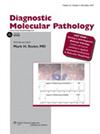More breast cancer metastases found in nonsentinel lymph nodes using a novel molecular method.
引用次数: 0
Abstract
To the Editor: We read with considerable interest the recent study by Vegue et al1 published in the June issue of Diagnostic Molecular Pathology. In that study, the authors compared the use of routine histologic assessment and onestep nucleic acid amplification (OSNA) assay for the staging of axillary lymph nodes in breast cancer patients with positive sentinel nodes (SNs). Comparison of the rate of metastasis obtained from histologic examination of a single tissue section from the central 1mm portion of each non-SN with that obtained from an OSNA assay of the remaining tissue revealed a far higher rate of metastasis with OSNA than with routine histology (53% vs. 11%). In particular, we note that Vegue and colleagues found micrometastases in 58% of OSNA-positive nodes. We obtained very similar results in a recently published study. Using a slightly different study design, we compared the detection rates of nonSN metastasis using the OSNA assay with those obtained through singlesection histology and found a much larger proportion of patients with nonSN metastases when analyzed with OSNA than with histology (56% vs. 20%). In particular, a much larger percentage of patients with micrometastases were observed with the OSNA assay (30% vs. 2%). Despite the slight difference in study design, we believe that our results complement those of Vegue and colleagues and confirm that a higher rate of non-SN micrometastasis is obtained with OSNA than with routine single-section histology in patients with SN-positive breast cancer. We note that neither our study2 nor the study conducted by Vegue et al1 revealed statistically significant upstaging according to the staging criteria of the American Joint Committee on Cancer. This is largely explained by the fact that, in the majority of cases, routine histology failed to identify micrometastasis in 1 or 2 nodes and this was insufficient to lead to upstaging. Nevertheless, cases were upstaged in both studies, and it is possible that a statistically significant effect would be observed in a larger cohort. Currently, it remains unclear whether identifying additional non-SN micrometastases with the OSNA assay has an impact on clinical outcome. However, several lines of evidence suggest that affected patients would have a worse survival rate. A recent study showed that identifying axillary metastasis beyond the SN is an important determinant of patient outcome independently of the number of involved nodes.3 Another study revealed no prognostic cutoff in the number of axillary nodes containing metastasis and questioned the rationale of applying a nodal cutoff.4 Moreover, a prospective study with long-term follow-up showed that detection of occult metastases by molecular analysis has a prognostic impact. In light of these findings, long-term follow-up of the patients in our study2 and that of Vegue et al should help to clarify the prognostic implications of applying this novel method to the staging of axillary lymph nodes, with possible consequences for the staging of SNpositive breast cancer.使用一种新的分子方法在非前哨淋巴结中发现更多乳腺癌转移。
本文章由计算机程序翻译,如有差异,请以英文原文为准。
求助全文
约1分钟内获得全文
求助全文
来源期刊
自引率
0.00%
发文量
0
审稿时长
>12 weeks
期刊介绍:
Diagnostic Molecular Pathology focuses on providing clinical and academic pathologists with coverage of the latest molecular technologies, timely reviews of established techniques, and papers on the applications of these methods to all aspects of surgical pathology and laboratory medicine. It publishes original, peer-reviewed contributions on molecular probes for diagnosis, such as tumor suppressor genes, oncogenes, the polymerase chain reaction (PCR), and in situ hybridization. Articles demonstrate how these highly sensitive techniques can be applied for more accurate diagnosis.

 求助内容:
求助内容: 应助结果提醒方式:
应助结果提醒方式:


